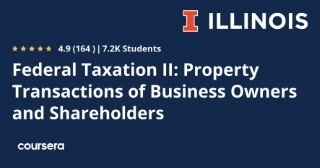Taxation of Business Entities II: Pass-Through Entities
Learn about U.S. federal income taxation of pass-through business entities, including partnerships and limited liability companies. Understand the formation, operation, and termination of these entities, along with tax treatments of distributions and sales. Develop technical tax knowledge and professional skills.
This course provides an introduction to the U.S. federal income taxation of pass-through business entities, including Subchapter S corporations, partnerships, and limited liability companies. The course focuses on the relevant provisions of Subchapters S and K of the Internal Revenue Code, as well as related Treasury Regulations and judicial opinions, governing the formation, operation, and termination of pass-through entities. Practical in-class study problems facilitate self-discovery of technical tax knowledge along with the development of a variety of professional skills and attitudes.
What you will learn
Introduction to Course
In this module, you will become familiar with the course, your instructor and your classmates, and our learning environment. This orientation will also help you obtain the technical skills required to navigate and be successful in this course.
Module 1 Partnership Formation
In this module, you will be introduced to partnerships. We will delve into the formation of partnerships along with the characteristics that differentiate this form of business from other U.S. entities. This module focuses on the eligibility of legal ‘persons’ to form a partnership and the nonrecognition provisions and holding periods that apply to the contribution of such capital. Exceptions to the nonrecognition rules will be highlighted along with additional elections and treatments available to partnership formation.
Module 2 Partnership Operations
In this module, you will be introduced to the operations of a partnership. We will examine how the operations of a partnership are a conduit by which transactions “pass through” to the partners. The module focuses on how the partnership measures and allocates the income based on the partner’s distributive share in accordance with the appropriate means of reporting. Next, we will discuss the appropriate adjustments to the partner’s outside tax basis in relation to the income, loss, and liability claims of the partnership. Finally, we will discuss the loss and related party limitations imposed on the partnership.
Module 3 Partnership Distributions
In this module, you will be introduced to the tax treatments of partnership distributions. We will first determine what is a distribution and how it is different from a partner’s share of partnership earnings. Partnership distributions will be further classified into proportionate operating, proportionate liquidating, and disproportionate distributions. We will then discuss the nonrecognition principle of partnership distributions, loss limitations, and exceptions to these general rules.
Module 4 Partnership Sales and Terminations
In this module, you will be introduced to the tax consequences of selling and terminating a partnership interest. We will explore the tax consequences to the buyer and seller in a transaction to sell a partner’s interest. You will learn to differentiate between sales subject to capital and ordinary gain. Since the partner’s capital account and tax basis often differ at the point of sale, you will learn about the § 754 election, which allows the buyer to step up the inside basis in the partnership. Finally, we will discuss the implications of partnership termination.
User Reviews
Be the first to review “Taxation of Business Entities II: Pass-Through Entities”
You must be logged in to post a review.







There are no reviews yet.